ISSN ONLINE(2319-8753)PRINT(2347-6710)
ISSN ONLINE(2319-8753)PRINT(2347-6710)
Jaya S.Pillai1, Vijayan N.2
|
| Related article at Pubmed, Scholar Google |
Visit for more related articles at International Journal of Innovative Research in Science, Engineering and Technology
This study investigates the potential of constructed wetlands to function as Ecological Sanitation systems, achieving water reuse, nutrient reuse and biomass production. Vertical flow constructed wetland systems planted with indigenous species such as Napier Bajra Hybrid grass (Pennisetum purpureum x Pennisetum typhoides) and Guinea grass (Panicum maximum) were developed for the treatment and utilization of Greywater for non-potable purposes. The performance of the control and experimental systems were analysed and compared based on water quality parameters such as Turbidity, Biochemical Oxygen Demand (BOD), Chemical Oxygen Demand (COD), Total Suspended Solids (TSS), Nitrates, Phosphates, and Total Nitrogen (TN). The study also estimated and compared the above ground biomass yield from the constructed wetland systems. For all the water quality parameters analysed during the study period, the vertical flow constructed wetland system planted with Napier Bajra Hybrid grass achieved high removal efficiency. Best removal efficiencies observed were: Turbidity (99%), TSS (93%), BOD (94%), COD (82%), Nitrates (88%), Phosphates (63%) and TN (60%). The final effluent concentration of the parameters tested reached the standards required for non-potable purposes as per the USEPA guidelines for water reuse. The annual above ground biomass yield (from 6-8 harvests) of Napier Bajra Hybrid grass was found to be higher (200 -250 t/ha) when compared to Guinea grass (60-72 t/ha). Based on the results, the constructed wetland system planted with Napier Bajra Hybrid grass proved to be a reliable, onsite and decentralised Ecological Sanitation system.
Keywords |
| Ecological Sanitation, Vertical flow constructed wetland, Water reuse, Nutrient reuse, Biomass Production |
INTRODUCTION |
| Water problems with respect to increased scarcity and degraded quality are now present in different parts of the world and are becoming increasingly serious. One of the reasons for this water crisis can be attributed to the failure of the current sanitation paradigm. The present situation of wastewater management and sanitation consists of using surface and groundwater as a sink for wastewater, resulting in increasing health hazards, environmental and water pollution, the steady degradation of natural resources and also the permanent loss of nutrients and organics from the soil sphere. As precious water is used as a medium to transport the wastes, these systems are becoming increasingly more difficult to be applied in regions of aggravating water scarcity [5]. The current sanitation system is failing in sustainability, threatening the integrity of fresh water supplies, and in creating unsustainable linear flows. In order to reach the United Nations Millennium Development Goals to halve the number of people without access to safe water and adequate sanitation by 2015, new holistic concepts are needed, focusing on economically feasible, closed-loop Ecological Sanitation (Eco-San) systems rather than on expensive end-of-pipe technologies [17]. |
| Ecological sanitation or Eco-San represents a new paradigm, one that offers a path out of the current vicious circles of water over-consumption, lack of access to safe water and sanitation and high costs for the poor, water and environmental pollution and depletion of nutrients. The new paradigm in sanitation is based on ecosystem approaches and the closure of material flow cycles rather than on linear, expensive and energy intensive end-of-pipe technologies. Eco-san does not favour a particular technology but is rather a philosophy in recycling oriented resource management and offers modern, convenient, gender friendly and desirable solutions [5],[6],[9] . Ecological Sanitation or Eco-San is based on a combination of traditional techniques and new approaches such as water saving, wastewater reuse and recycling, nutrients recovery and biomass production for energy [6]. These systems enable the recovery of nutrients for the benefit of agriculture, thus helping to preserve soil fertility, assure food security for future generations, minimize water pollution and recover bioenergy. They ensure that water is used economically and is safely recycled to the greatest possible extent for purposes such as irrigation or groundwater recharge [5], [17],[22]. |
| This paper investigates the potential of constructed wetlands (CWs) to function as Eco-San systems considering the aspects of water reuse, nutrient reuse and biomass production. Since the mid 1990s, constructed wetlands have been increasingly used as a low energy ‘green’ technique, in the treatment of wastewater, driven by the rising cost of fossil fuels and increasing concern about climate change [4]. Constructed wetlands are gaining importance as a sustainable technology for the ecological treatment of wastewater and can play an important role in ecological sanitation concepts [1], [10]. A constructed wetland is an engineered ecosystem with plants and rhizosphere microorganisms living in a physical infrastructure to remove pollutants in waste water. They are man-made copies of natural wetlands that optimally exploit the biogeochemical cycles that normally occur in these systems for the purpose of wastewater treatment [14]-[16]. Constructed wetlands emerged as an alternative to the conventional wastewater treatment plant, which can be used as part of decentralized wastewater treatment systems and are a robust and “low tech” technology with low operational requirements [3],[7],[10],[13]. Among various applications of these wetlands, a significant area is the removal of nitrogenous pollutants to protect the water environment and to enable effective reclamation and reuse of the wastewater [11], [19] - [21]. |
| The potential for application of constructed wetland technology as an Eco-san system is enormous in India, but the rate of adoption has been found to be very slow. Climatic conditions in India, especially Kerala favour the application of constructed wetland technology. However, very few studies have been reported investigating the potential of constructed wetlands to function as Eco-San systems in India. Also very few studies focus on the potential of coupling wastewater treatment with valuable biomass production in constructed wetlands. Through the cultivation of suitable indigenous wetland vegetation in a CW, benefits can be expected in the form of water quality improvement as well as monetary benefits from biomass production. Therefore it is imperative to identify indigenous, highly tolerant, and valuable perennial grasses with potential for wastewater treatment as well as with high biomass productivity. However no studies have been reported on the applicability of indigenous plant species in constructed wetlands, suitable to agro-climatic conditions of Kerala. This research holds out the promise of being able to use constructed wetlands as a means of sustainable agriculture while providing quantifiable water quality improvement. Combining wastewater treatment with biomass production in constructed wetlands can achieve a win-win situation of both environmental pollution control and bio-energy production. Biomass produced by plants in CWs provide added values as biofuel, livestock forage, medicines, pulp and paper production, soil conditioner, compost etc. Apart from that, constructed wetlands provide ecological benefits such as carbon sequestration, habitat creation, biodiversity conservation, Ground water recharge etc. |
| The objectives of the study were: |
| • To investigate the potential of subsurface Vertical Flow Constructed Wetland (VFCW) systems planted with indigenous species to function as Eco-san systems considering the aspects of water reuse, nutrient reuse and biomass production. |
| • To study and compare the performance of VFCW systems planted with Napier Bajra Hybrid grass (Pennisetum purpureum x Pennisetum typhoides) and Guinea grass (Panicum maximum) for the treatment and utilization of greywater for non-potable purposes. |
MATERIALS AND METHODS |
| A. Analysis and characterisation of raw Greywater |
| The experimental VFCW and control systems were constructed in the backyard of a private residence in Thiruvananthapuram. Raw Greywater samples required for the study were collected from the household. Collection was made by careful manual sampling and detailed analysis and characterization of the samples were carried out as per the Standard methods [2]. The results are indicated in Table 1. |
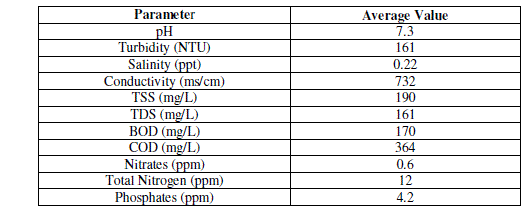 |
| B. Design of experimental VFCW systems |
| Two experimental subsurface VFCW systems each of dimension 1.25m (length) x 0.65m (width) x 0.5m (depth) were designed based on the flow rate and organic loading rate [18]. A control system with unplanted filter bed was developed to compare the results and to study the role of vegetation in CW systems. The flow rate was maintained at 80 Litres/day. Greywater was fed into the wetland bed through the inlet arrangement connected to a feeding tank with an intermittent feeding mechanism of 40Litres per feed. A dosing interval of 12 hours was provided between successive feeds. The wastewater drains vertically down through the filter bed and the treated water was collected through the outlet provided at the bottom. The main characteristics of the CW systems are shown in Table 2. |
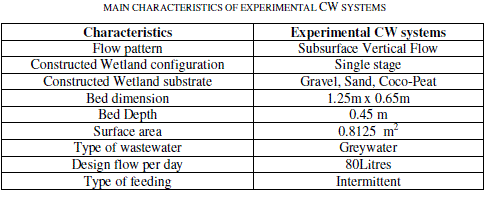 |
| C. Filter bed |
| The filter bed consisted of a 15cm lower layer of gravel (10-20mm size), followed by a 20 cm middle layer of coarse sand and 8cm upper layer of coco-peat (organic soil component) . A 2cm layer of gravel was filled over the coco–peat layer to prevent any accumulation of water. An inlet and outlet was provided to each system. The bed bottom slope was oriented 1% towards the outlet. |
| D. Wetland Vegetation |
| The choice of vegetation (i.e. crop) is extremely important in the design of a constructed wetland. Wetland plants influence oxygen levels in the wetland water and soil and help provide underwater surface area for the colonization of bacteria. If a treatment wetland is also to be harvested, the chosen vegetation should also produce sufficient amounts of harvestable biomass. |
| The plant species used in the first experimental VFCW system was Napier Bajra Hybrid grass (Pennisetum purpureum X Pennisetum typhoides). This superior hybrid variety named “Suguna’ was developed by Kerala Agricultural University and is a high yielding perennial valuable fodder grass. It grows throughout the year in the tropics and is very much suitable to the agro-climatic conditions of Kerala. Hybrid Napier is a perennial grass which can be retained on field for 2-3 years. Compared to Napier grass, Hybrid Napier produces more tillers and numerous leaves. It has high tillering capacity, green forage yield, regeneration capacity, leaf to stem ratio and crude protein content [12]. Napier Bajra Hybrid grass is highly valued as green fodder, silage and hay and it has been identified as a potential bio-fuel crop. The high sugar content of this grass makes it an excellent raw material for the production of second generation cellulosic bio-fuels like ethanol and butanol. Napier Bajra grass has great potential as a biofuel feedstock primarily because of its high yield potential [12]. |
| The stem cuttings of Pennisetum purpureum X Pennisetum typhoides (Napier Bajra Hybrid grass) were obtained from Kerala Agricultural University and were used for planting in experimental VFCW1. A total number of 8 stem cuttings were planted in 2 rows with plant spacing of 30 x 30 cm. |
| The plant species used in the second experimental VFCW system was Guinea grass (Panicum maximum). Guinea grass is a popular fodder grass of the tropics and is suitable to the agro-climatic conditions of Kerala. It is an excellent fodder much valued for its high productivity, palatability and good resistance. Guinea grass is profitably grown as a component of agro-forestry systems. The root system is dense, deep and fibrous. The recommended spacing of pure crop is 60 x 30 cm [12]. The slips of Panicum maximum (Guinea grass) were obtained from Kerala Agricultural University. A total number of 8 seedlings were planted in 2 rows with plant spacing of 30 x 30 cm. |
| E. Experimental Wetland Construction |
| The study consisted of two experimental VFCW systems and a control system. Each CW system consisted of a rectangular bed built in brick masonry with the dimension as per the design. Experimental VFCW systems were constructed by filling the filter bed with selected filter media and growing the selected plant species. After preparation of filter bed with gravel, sand and coco-peat, the seedlings of Pennisetum purpureum X Pennisetum typhoides were transplanted to the prepared bed of the first experimental VFCW system. In the same way, the seedlings of Panicum maximum were transplanted to the prepared bed of the second CW system. Initially, the plants in both experimental systems were watered with fresh water daily for one month for plant establishment. An acclimatisation period of one month was provided. Greywater was fed intermittently to the systems for a period of 8 months from December 2012 to July 2013. Plants were monitored for general appearance, growth and health. The experimental VFCW systems planted with Pennisetum purpureum x Pennisetum typhoides and Panicum maximum are shown in figure 1 and figure 2 given below. |
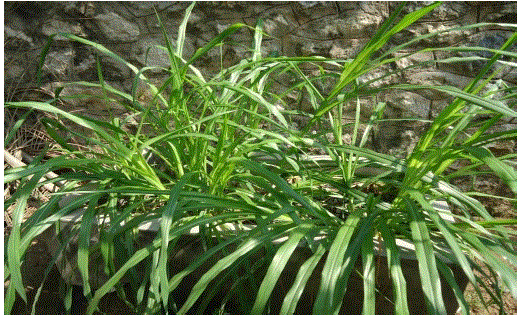 |
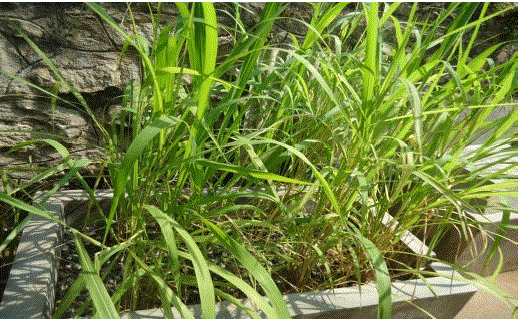 |
RESULTS AND DISCUSSION |
| In order to study the treatment efficiency of VFCW systems, raw and treated GW were sampled periodically and analyzed for a variety of water quality parameters such as pH, Turbidity, BOD, COD, TSS, Nitrates, Phosphates, and TN. The sampling at both inlet and outlet was carried out monthly during the study period of 8 months. The results obtained for control and planted VFCW systems were analyzed and compared for performance and treatment efficiencies. Also the biomass yield from the different VFCW systems were estimated and compared. The first harvesting of plants in the experimental VFCW systems was done after 120 days of planting and the second harvest after 60 days interval. |
| A. Turbidity |
| A significant reduction in turbidity was achieved in both the control as well as experimental VFCW systems. The highest removal efficiency of turbidity obtained in the CW system planted with Napier Bajra Hybrid grass and Guinea grass were 99% and 98% respectively. The control system with unplanted filter bed attained a mean turbidity removal efficiency of 87.32%. The high removal rates of turbidity can be attributed to the various pollutant removal mechanisms taking place in the CW system such as sedimentation, filtration, adsorption etc. Figure 3 shows the turbidity removal rates with time in different CW systems. The turbidity removal rates have been found to be increasing with time in the case of planted VFCW systems signifying the role of root zone treatment. |
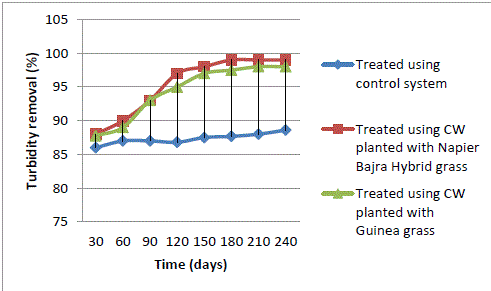 |
| B. Total Suspended Solids (TSS) |
| The TSS removal with time in the control as well as CW systems is shown in the Figure 4. The control system obtained a mean removal efficiency of 65%. Highest removal efficiencies observed in CW systems planted with Napier Bajra Hybrid grass and Guinea grass were 93% and 89% respectively. It is clear that in the planted CW systems, there is a continuous treatment process and that as the plant grows on, better removal efficiencies are observed. |
| C. Biochemical Oxygen Demand (BOD) |
| The profile of BOD removal rate with time for control as well as treatment CW systems is shown in Figure 5. The control system achieved a mean BOD removal efficiency of 39.2%. Mean removal efficiency of 84% was obtained for the CW system planted with Napier Bajra Hybrid grass, whereas, the mean removal efficiency of CW planted with Guinea grass was obtained as 79%. |
| For both planted VFCW systems, the peak BOD removal was observed after 90 days and thereafter attained an almost steady removal rate. The VFCW system planted with Napier Bajra Hybrid grass attained a maximum BOD removal efficiency of 94%, while the system with Guinea grass attained a maximum removal of 89%. The high BOD removal can be attributed to various treatment mechanisms taking place in constructed wetlands such as sedimentation, filtration, bacterial degradation, plant metabolism, adsorption etc. |
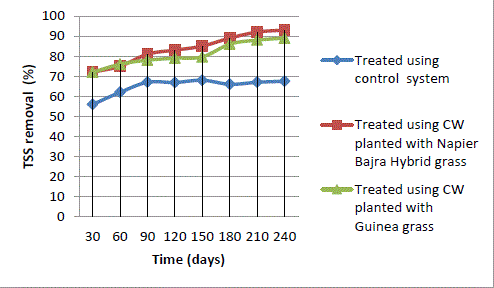 |
| D. Chemical Oxygen Demand (COD) |
| For the VFCW planted with Napier Bajra Hybrid grass, the maximum COD removal efficiency obtained was 82%, while in the case of CW Guinea grass, the removal efficiency obtained was 79%. The control system achieved a mean COD removal efficiency of 35%. Figure 6 shows the profile of COD removal with time. |
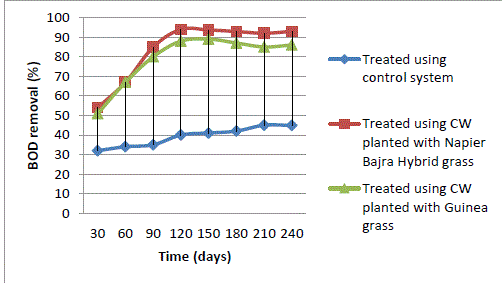 |
| E. Nutrient Removal |
| The rate of nutrient removal was estimated from the concentrations of nitrate, Total Nitrogen and phosphate in the effluent at the exit of the vegetated and the control wetlands. For all the nutrient parameters considered, the absorption rates in the planted VFCW systems were higher than that in the unplanted control system. This indicates the significance of the role of plant uptake of nutrients. In the case of both experimental VFCW systems planted with Napier Bajra Hybrid and Guinea grass, the best removal efficiency of nitrates and phosphates were observed after 90 days of planting. This indicates that the nutrient removal efficiency progressively increased with the growth of the plants, attained a peak value and then slightly declined as the plant attains a maturation stage. It was also observed that the nutrient removal increased after the first (after 120 days of planting) and second harvesting period. The CW system planted with Napier Bajra Hybrid grass achieved high nitrate, phosphate and TN removal when compared to the system planted with Guinea grass. The best removal efficiencies obtained for CW system planted with Napier Bajra hybrid grass were: Nitrates (88%), Phosphates (63%) and TN (60%). For the CW system planted with Guinea grass, the best removal efficiencies observed were: Nitrates (78%), phosphates (58%) and TN (58 %). |
| The removal of Nitrogen in CW systems can be attributed to different processes such as nitrification, denitrification and plant uptake. Organic Nitrogen is mineralized to ammonia by hydrolysis and bacteria degradation. Ammonia is then oxidized to nitrate by nitrifying bacteria in the aerobic zones of the CW system. The oxygen required for nitrification is supplied by transmission from the atmosphere and leakage from macrophyte roots. Nitrates are then converted to nitrogen gas (N2) and nitrous oxide (N2O) by denitrifying bacteria in anoxic and anaerobic zones which usually occur in limited oxygen supply. Nitrogen is also taken up by plants, incorporated into the biomass and released back as organic nitrogen after decomposition. Phosphorus removal can be achieved in CWs by adsorption and precipitation, and also by plant uptake. Removal of Nitrates, TN and Phosphates with time in the different CW systems is shown in the figures 7, 8 and 9 respectively. |
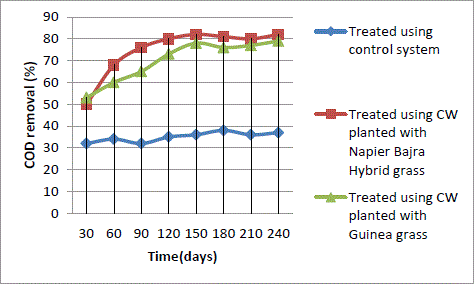 |
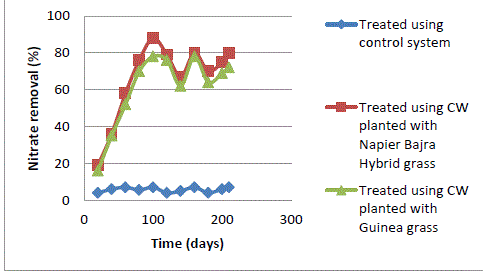 |
| F. Comparison of Greywater treatment in control and VFCW systems |
| For all the water quality parameters tested, the planted VFCW systems achieved high removal rates than the control system with unplanted filter bed. The best removal efficiencies of parameters observed in the control system were as follows: Turbidity (88.6%), TSS (68%), BOD (45%), COD (38%), Nitrates (7%), TN (14%), and Phosphates (7%). Among the planted experimental VFCW systems, the system planted with Napier Bajra Hybrid grass obtained high removal efficiencies than the system planted with Guinea grass. The best removal efficiencies observed in the VFCW1 system planted with Napier Bajra Hybrid grass were as follows: Turbidity (99%), TSS (93%), BOD (94%), COD (82%), Nitrates (88%), TN (60%), and Phosphates (63%). For the VFCW system planted with Guinea grass, the best removal efficiencies observed were as follows: Turbidity (98%), TSS (89%), BOD (89%), COD (79%), Nitrates (78%), TN (58%), and Phosphates (58%). The figure 10 shows the mean removal efficiencies of the main parameters obtained in the different systems. |
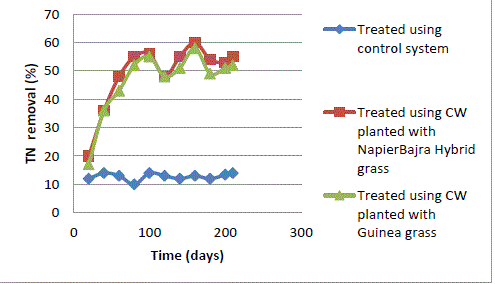 |
| The Table 3 given below shows the final effluent concentration of the various parameters obtained in the control as well as planted VFCW systems and compares it with the USEPA guidelines for non-potable reuse. Results prove that the final effluent concentration of the parameters tested reached the standards required for non-potable purposes as per the USEPA guidelines for water reuse. |
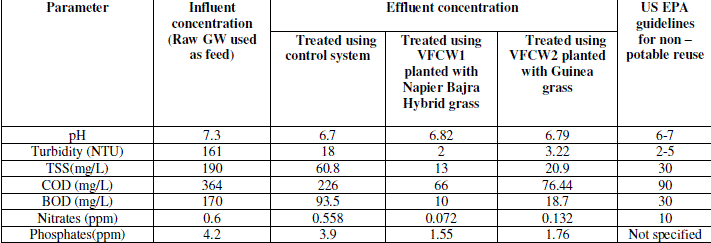 |
| G. Biomass Yield |
| The above ground biomass yield obtained from the two experimental VFCW systems is shown in the Table 4. The annual green yield (from 6 harvests) of Napier Bajra Hybrid grass was calculated to be 200-250 tonnes/ hectare and that of Guinea grass as 60-80tonnes/ hectare. |
 |
CONCLUSION |
| In this study, VFCW systems planted with perennial grasses suitable to the tropical and agro-climatic conditions of Kerala were developed for the treatment of Greywater for non-potable reuse. The study analysed and compared the performance of subsurface VFCW systems planted with indigenous species such as Napier Bajra Hybrid grass (Pennisetum purpureum x Pennisetum typhoides) and Guinea grass (Panicum maximum) for the treatment of greywater and also compared the biomass yield from the CW systems. |
| Based on the monthly tests performed during the study period, the planted VFCW systems achieved water quality improvement with high removal rates of turbidity, TSS, BOD, COD, Nitrates, Phosphates and TN. For all the water quality parameters tested, high removal efficiencies were observed in the case of VFCW1 system planted with Napier Bajra Hybrid grass than for VFCW2 system planted with Guinea grass. Best removal efficiencies observed for VFCW1 system planted with Napier Bajra Hybrid grass were: Turbidity (99%), TSS (93%), BOD (94%), COD (82%), Nitrates (88%), Phosphates (63%) and TN (60%). The final effluent concentration of the parameters tested from the planted VFCW systems reached the standards required for non-potable purposes as per the USEPA guidelines for water reuse [8]. The high removal rates of the pollutants from Greywater indicate the importance of physical, chemical and biological mechanisms occurring in the CWs. The annual above ground biomass yield (from 6-8 harvests) of Napier Bajra Hybrid grass was found to be higher (200 -250 t/ha) when compared to Guinea grass (60-72 t/ha). |
| Based on the results, the VFCW system planted with Napier Bajra hybrid grass proved to be a robust and reliable on-site and decentralized Eco-san system considering the aspects of water reuse, nutrient reuse and biomass production. The high biomass yield of Napier Bajra Hybrid grass makes it a possible potential feedstock in producing cellulosic ethanol, with the added benefit of water quality improvement. This study suggests that through the cultivation of highly productive, low input, perennial and valuable plant species in the CW, benefits can be realized in the form of water quality improvement, water reuse, nutrient reuse and biomass production. |
References |
|